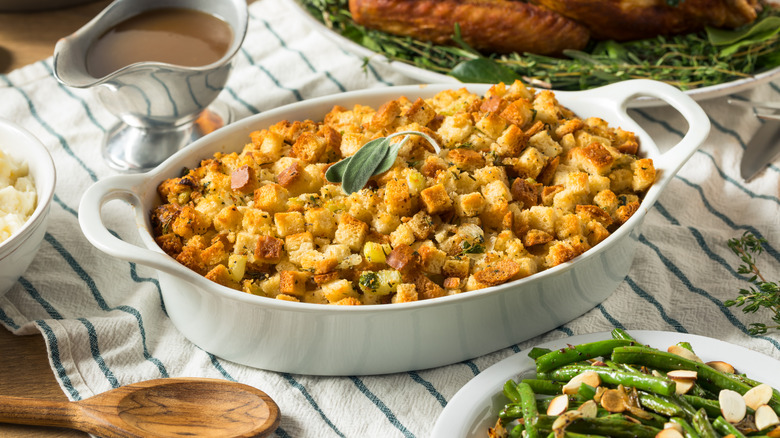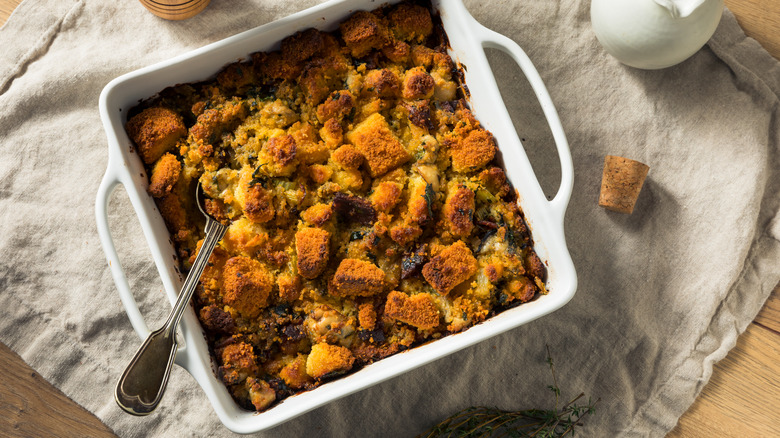Anything Can Become Stuffing If You Put Your Mind To It
The Thanksgiving table is often crowded with starchy offerings, but no side dish commands as much potential as the stuffing. At its worst, stuffing can be dry and bland, but at its best, it's that rare recipe that can outshine the main star of the day — roasted turkey. The beauty and the burden of a properly made stuffing lies with the maker. Yes, your stuffing is dependent on the cook's creativity and good sense. But that's actually a good thing!
Because the formula for stuffing is so simple, it makes riffing on the original recipe extremely easy. Bread, herbs, and moisture (be it eggs, milk, stock, or a mix of all three) combine to create an aromatic and starchy casserole ready to accompany your beautiful roasted bird. The addition of protein — either in the form of salty meat or briny seafood — isn't required but can add a boost of savory decadence. Vegetables, herbs, toasted nuts, dried fruit, and other flavorful ingredients are equally welcome to the stuffing base — you just need to know the right ratios.
Standard stuffing ratios
First, let's address these all-important ratios to creating a well-balanced stuffing recipe. A basic stuffing uses up to 12 to 14 cups of dried bread cubes of your choice (dried out in the oven if not already suitably stale). The other essential ratios to keep in mind are at least 2 eggs to bind the mix together, 1 cup melted butter for rich flavor, and 2 to 2½ cups of liquid (stock or milk works well) for moisture.
Next, you need to consider how many mix-ins your stuffing can hold. Most recipes that are designed for a 9 by 13 pan have enough room for about half a pound of meat or shellfish (typically oysters, but feel free to get a little crazy with some crab meat if you want), plus 3 to 4 cups of chopped vegetables or other chunky mix-ins. Go crazy with the amount of herbs you want to add, just know that dried herbs will pack a stronger punch than fresh ones. A good rule of thumb is that a teaspoon of dried herbs is equivalent to a tablespoon of fresh. You can be generous with the seasoning and spices as well since the absorbent bread can take plenty of flavor.
Picking your ingredients
Now let's tackle all the different ingredients that are fair game for a dish of stuffing. For bread, cornbread is a traditional option but feel free to make any spongy or crusty loaf as your base. Sourdough will incorporate tang while a rye loaf brings earthy flavor. Even a gluten-free loaf will work. Try to avoid flatbread as it won't absorb enough moisture for a good texture.
For salty protein, chopped bacon, ham, or other cured meat will add a lot of flavor while requiring only a small amount to be added in. Sausage, particularly ground sausage spiced with Italian seasoning, is also a classic addition as are smoked or raw oysters. More unconventional options, like chorizo, could work here too. If you'd rather keep your stuffing protein-free, think of adding a dash of umami-rich ingredients like soy sauce, Worcestershire sauce, or nutritional yeast to make up for the savory flavor.
When you choose your vegetables, think of picking ones that add depth to dishes, like celery, fennel, bell pepper, onion, and poblanos. Peppery greens like collards or kale are nice too. Wild card additions include sun-dried tomatoes, dried cranberries, or pickled vegetables (the star of spicy sourdough stuffing). As far as herbs go, classic options include sage, thyme, tarragon, and rosemary (traditional poultry herbs), but think about looking at mixes like herbs de Provence for an added punch. Or turn to spice blends, from Chinese five spice to Old Bay seasoning, for a unique taste.



